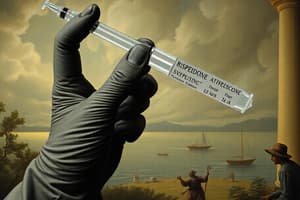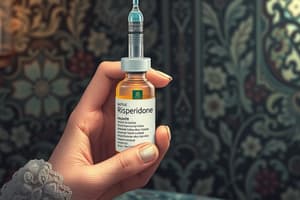Podcast
Questions and Answers
What is the classification of Risperidone?
What is the classification of Risperidone?
- Stimulants
- Antipsychotics, mood stabilizers (correct)
- Benzodiazepines
- Antidepressants
What is the action of Risperidone?
What is the action of Risperidone?
May act by antagonizing dopamine and serotonin in the CNS.
The typical adult dosage of Risperidone for schizophrenia is _____ mg daily.
The typical adult dosage of Risperidone for schizophrenia is _____ mg daily.
4-8
In pediatric patients (ages 13-17 years), the typical adult dosage of Risperidone for schizophrenia is _____ mg daily.
In pediatric patients (ages 13-17 years), the typical adult dosage of Risperidone for schizophrenia is _____ mg daily.
What are some indications for using Risperidone?
What are some indications for using Risperidone?
Which of the following is a common side effect of Risperidone?
Which of the following is a common side effect of Risperidone?
There are listed toxic symptoms for Risperidone.
There are listed toxic symptoms for Risperidone.
What is one implication for nursing when administering Risperidone?
What is one implication for nursing when administering Risperidone?
Flashcards are hidden until you start studying
Study Notes
Classification
- Therapeutic class: antipsychotics, mood stabilizers
- Pharmacologic category: benzisoxazoles
Action
- Antagonizes dopamine and serotonin in the central nervous system (CNS)
- Therapeutic effects include decreased symptoms of psychosis, bipolar mania, and autism
Dosage/Route
-
Schizophrenia:
- Adults: start at 1 mg twice daily, titrate by 1-2 mg every 24 hours to achieve 4-8 mg daily
- Adolescents (13-17 years): start at 0.5 mg once daily, titrate to a maximum of 3 mg daily
- Adults (IM): 25 mg every 2 weeks, higher doses may be used (37.5 mg or 50 mg)
-
Bipolar I Disorder:
- Acute manic episodes (Adults): 2-3 mg/day as a single dose, titrate by 1 mg every 24 hours (range 1-5 mg)
- Adolescents (13-17 years): start at 0.5 mg once daily, titrate to 2.5 mg daily
-
Irritability with Autism:
- Children (5-16 years, 20 kg): start with 0.25 mg to 0.5 mg/day and can increase every 2 weeks.
-
Renal and Hepatic Impairment:
- Adults: start at 0.5 mg twice daily, titrate as needed
Indications
- Schizophrenia for adults and adolescents (age 13-17)
- Short-term treatment of acute manic/mixed episodes in Bipolar I Disorder for ages 10-17
- Maintenance treatment for Bipolar I Disorder (IM only for adults)
- Irritability associated with autistic disorder in children
Side Effects
- CNS: Neuroleptic Malignant Syndrome, suicidal thoughts, aggressive behavior, dizziness, extrapyramidal reactions, headaches, sleep disturbances, sedation, fatigue
- EENT: Pharyngitis, rhinitis, visual disturbances
- Respiratory: Cough, dyspnea
- Cardiovascular: Arrhythmias, orthostatic hypotension, tachycardia
- Gastrointestinal: Constipation, diarrhea, dry mouth, nausea, weight changes, abdominal pain
- Genitourinary: Libido changes, dysmenorrhea, urination difficulties
- Dermatological: Skin rash, photosensitivity, dermatitis
- Endocrine: Dyslipidemia, hyperglycemia
- Hematologic: Agranulocytosis, leukopenia
- Musculoskeletal: Arthralgia, back pain
Toxic Symptoms
- No specific toxic symptoms documented
Nursing Implications
- Assess mental status and mood before and during therapy
- Monitor for behavior changes indicating suicidal thoughts or worsening depression
- Monitor weight and BMI throughout therapy
- Regularly check for hyperglycemia indicators
- Assess blood pressure and pulse changes, especially during dose titration
- Ensure medication administration compliance to prevent hoarding
- Observe for extrapyramidal side effects, which may require dose adjustment or medication cessation
- Trihexyphenidyl or benztropine may assist in managing extrapyramidal symptoms if needed
Studying That Suits You
Use AI to generate personalized quizzes and flashcards to suit your learning preferences.




